Research in solid state physics is conducted in the Low Temperature Laboratory and Materials Science Facility in the Physics Department at Ithaca College. This lab, headed by Matthew C. Sullivan, focuses on the study of the behavior of electrons in solids. His work includes studies of high-temperature superconductors (with transition temperatures above the boiling point of liquid nitrogen, or -321 °F), semiconductors for use in the photoelectrolysis of water to promote a green fuel source, and semiconductors for use in neuromorphic computing, the next generation of high-power computers.
Students studying superconductors build magnetic levitation and suspension demonstrations. All the tracks were built at Ithaca College!
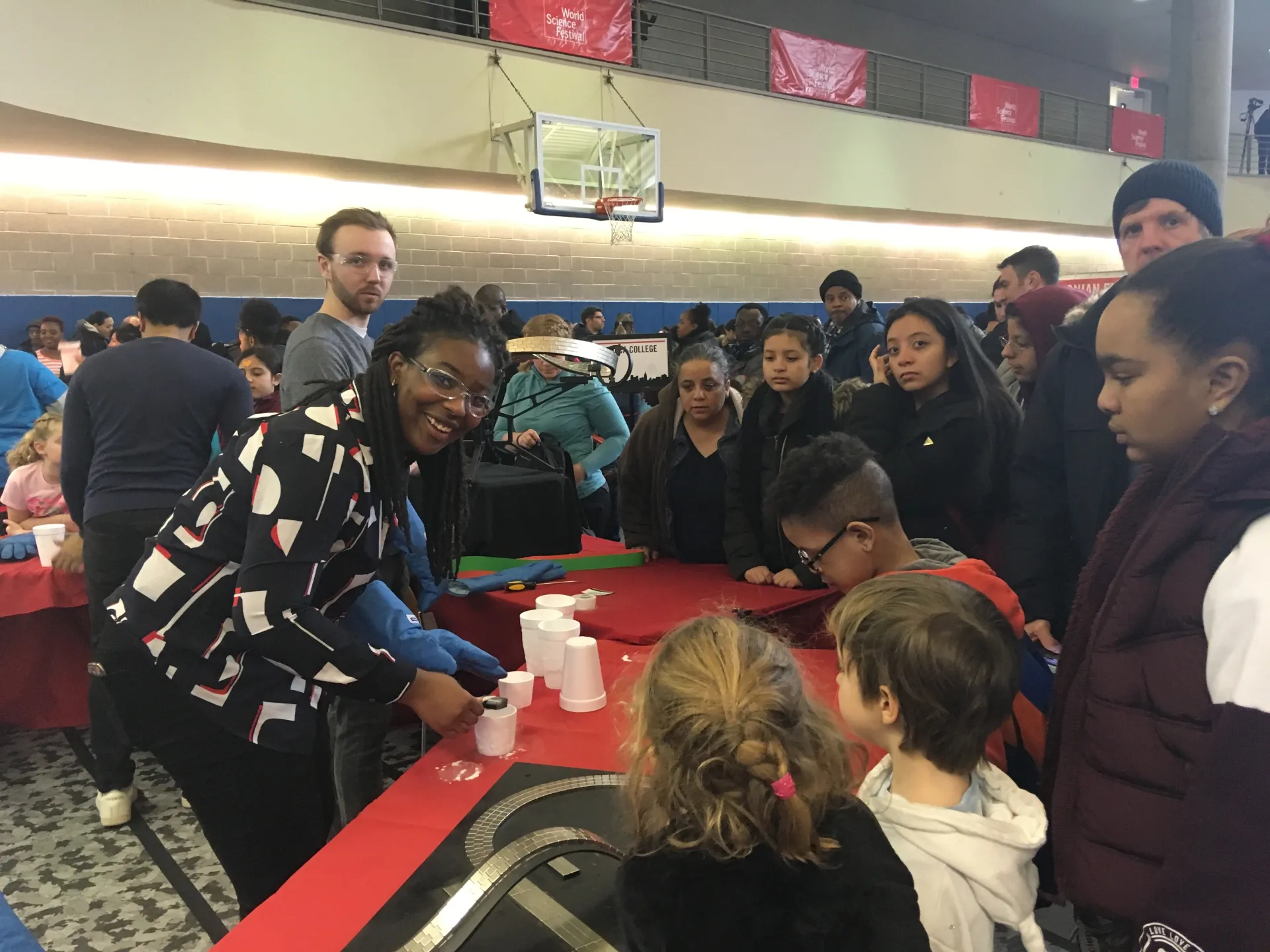
Oluwasekemi Odumosu '20 and Joshua Schmidt '23 demonstrating the low-temperature semiconductors at the World Science Fair.
Students in the Low Temperature Lab conduct electronic transport measurements (resistivity, Hall effect, etc.) in a variety of different superconducting and semiconducting materials. Our equipment can reach temperatures from 80 °C all the way down to 4 °C above absolute zero (-450 °F).
In the Materials Science Facility we use a pulsed laser deposition to make thin films of a variety of different materials. The facility also houses a profilometer and atomic force microscope to measure the surface morphology of the samples we grow.
We also regularly work at the Cornell NanoScale Science and Technology Facility, a world-class academic clean room processing facility. In this clean room facility we can make electronic devices much smaller than the thickness of a human hair.
Our research has been funded multiple times by the National Science Foundation.
Current Projects
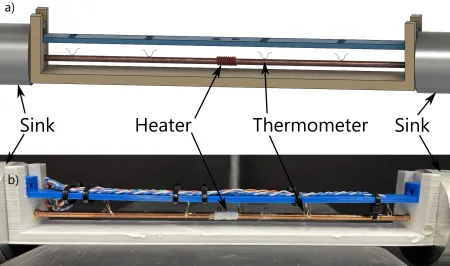
Thermal diffusion apparatus designed by Yash Mohod '25. The heater is in the center and two thermometers are on either side of the heater.
Measuring Heat Flow in metal rods
Matthew C. Sullivan
For nearly 400 years, experiment and theory have been the pillars of physics. In the 21st century, computer simulations are as important as theory and experiment, and can often explore physical situations that neither theory nor experiment can access. This research project uses a simple system – heat flowing in a metal rod – to explore all three pillars of 21st century physics.
The experimental apparatus is designed and built by Ithaca College students. We measure the temperature change in a metal rod and compare it to analytical predictions and numerical simulations.
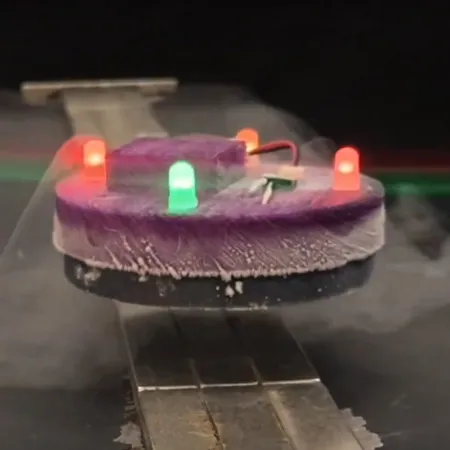
Levitation demonstration built by Kathy Wang, 2023
Interactive Quantum Levitation Demonstration
Matthew C. Sullivan
Ithaca College Physics and Astronomy students have successfully created many visually stunning demonstrations of flux-pinned superconductors – so called quantum levitation - on our Flat Track, Looped Track, and Möbius Strip Track. Now is the time to step up our game and create demonstrations that you can not only see but also interact with. This is an engineering project that will include the 3D printers and measurements of mechanical properties of the systems in question.
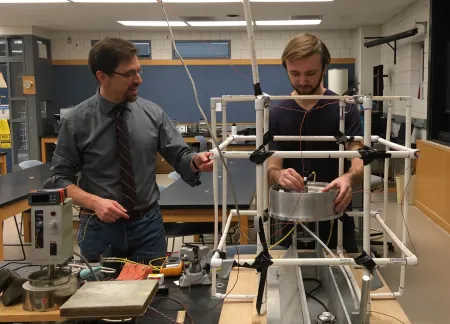
Physics major Joshua Schmidt '23 re-wires the spinning coil (inside the metal shield). The PVC pipes hold the 3-axis Hemlholtz coils.
Seeing the unseen
Matthew C. Sullivan
In 1916, Richard Tolman and Dale Stewart spun a coil of wire to high speeds and showed that electrons carry the current inside metals. A century of technological advances have made data collection easier thanks to the advent of modern electronics, but at the same time has buried the electrons’ motion underneath the ambient electrical noise inherent in any modern building. Can we use the tools and skills available in an undergraduate physics lab to detect the motion of the electrons in copper wire – without applying a voltage?
This project involved mechanical engineering in the design of the enclosure, the motor drive system, and the braking system. There is also electrical engineering in the data collection system, and computational physics in the filtering of the data after it has been collected. Something for everyone!
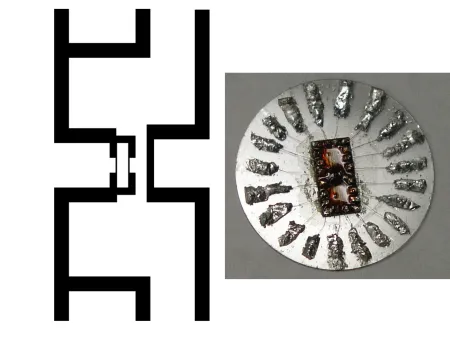
SQUID geometry and chip. The SQUID loop is about 10 microns wide and 30 microns long (left image). The sample itself is 5 mm wide by 10 mm long (right image). Design and photo by Charlie Strehlow '09
Measuring the magnetic Flux quantum
Matthew C. Sullivan
The Superconductiong QUuantum Interference Device (SQUID) is the most sensitive magnetic field detector. It can sense the smallest amount of magnetic flux that exists -- the magnetic flux quantum! This device is in use in multiple modern technologies -- including magnetoencephalography!
Here at Ithaca College we are working to create SQUIDs that can be used in an advanced lab setting. We grow thin-film superconductors in the Materials Science Facility at Ithaca College and then take the films to the Cornell NanoScale Science and Technology Facility for photolithographic patterning. Once patterned, we return to Ithaca College to measure then devices in our low-field, low-noise cryostat. This project includes modern thin-film growth via pulsed laser deposition, photolithographic patterning at the Cornell clean room, and electrical characterization and measurement at low temperatures.
Undergraduate students are integral members of the research team and participate in all aspects of the research project, from device fabrication to sample measurement, during both the summer and during the academic year.
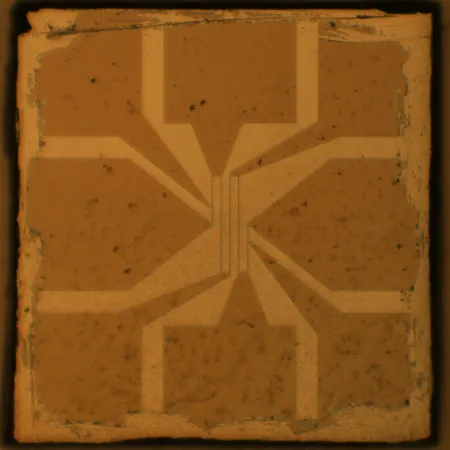
Thin film patterned for a meander wire. Sample is 5mm by 5 mm. The wire is 2 microns wide. Image by Emily Backus '12.
The Phase transition in Superconductors
Matthew C. Sullivan
How exactly do normal metals become superconductors? Physicists have studied the phase transition in superconductors for many years. There are many variables that control whether or not a metal can become a superconductor. The three most common environmental controls are: temperature, magnetic field, and electrical current. If the metal is too hot, or the magnetic field is too strong, or too much current flows in the superconductor, it will become a normal metal.
This project looks at the critical current in cuprate superconductors. We are trying to determine which model of the phase transition the critical current in superconductors follows. We grow the thin films for our measurements at Ithaca College in the Materials Science Facility. We pattern the films into very thin, long meander patterns at the Cornell NanoScale Science and Technology Facility, and then measure the devices in low-noice cryostats at Ithaca College. This project includes modern thin-film growth via pulsed laser deposition, photolithographic patterning at the Cornell clean room, and electrical characterization and measurement at low temperatures.
Here is a quick tour of the Low Temperature Physics Lab and the Materials Science Facility! Undergraduate students work with all the equipment shown here!
Center for Nanophysics and Advanced Materials in the Physics Department at the University of Maryland